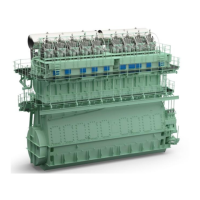Operation4003−1/A1
Winterthur Gas & Diesel Ltd.
8/ 12
4.6.1 Auxiliary Blowers Test from ECR Control Panel
1) Set to off the power supply to FCM−20 #4.
2) Make sure that there is command and feedback of the auxiliary blowers.
3) If there is no command and feedback, do a check of the cables to the starter
box(es).
4) Set to on the power supply to FCM−20 #4.
5) Set to off the power supply to FCM−20 #3.
6) Make sure that there is command and feedback of the auxiliary blowers.
7) If there is no command and feedback, do a check of the cables to the starter
box(es).
8) Set to on the power supply to FCM−20 #3.
4.7 Servo Oil System
1) Start the main bearing oil pump. Make sure that the operation pressure is
correctly adjusted.
2) For 9-cylinder engines: At the connecting pipe on the servo oil rail 4.11, make
sure that the stop valves 4.26−3, 4.26−4, 4.26−5 and 4.26−6 are open.
3) Start the servo oil service pump 4.88.
4) Make sure that the pressure in the servo oil rail 4.11 is approximately 100 bar.
You can see the related value on the WECS−9520 manual control panel display.
4.8 Exhaust Valve Drive
1) In the RCS, manually open the exhaust valve 4.01 on cylinder #1 (see 4002−3
paragraph 1.1 parameter Exv. A/M Cmd).
2) When the exhaust valve opens, record the value (mA) shown in the RCS EXV, of
the field Open position sensor.
3) On cylinder #1, close the exhaust valve 4.01.
4) When the exhaust valve is closed, record the value (mA) shown in the RCS, EXV
in the field Open position sensor 1.
5) Do the procedure given above for each exhaust valve.
Note: The values shown must be almost the same for all cylinders ±1.5 mA. If
not, an exhaust valve is not fully open or the sensors are defective.
6) In the RCS, set the parameters of each exhaust valve drive to AUTO (Exv. A/M
Cmd).
2017−08
Engine Control

